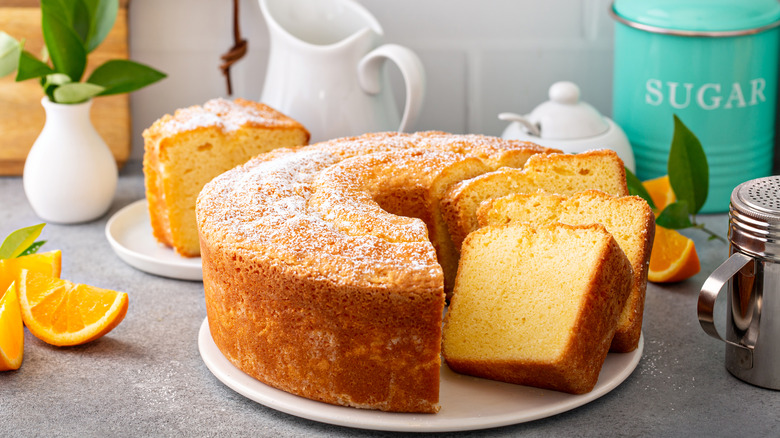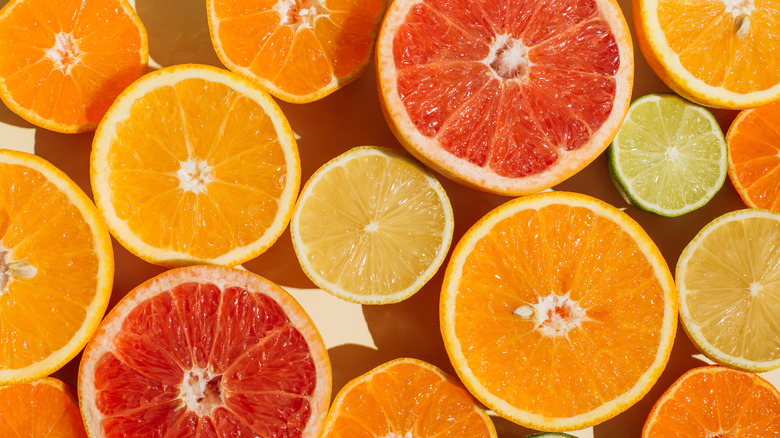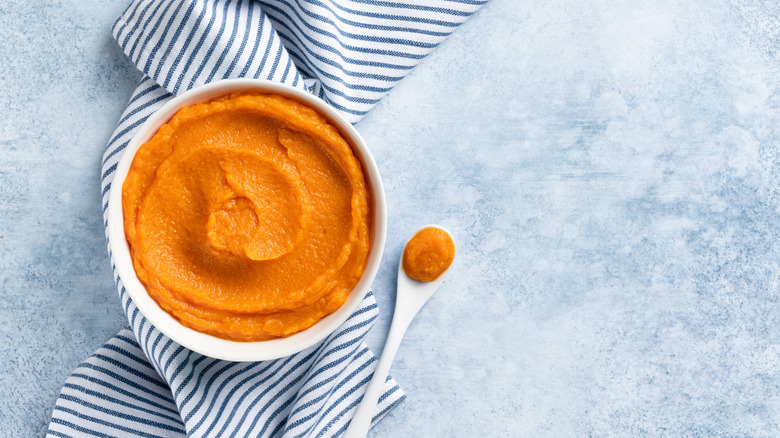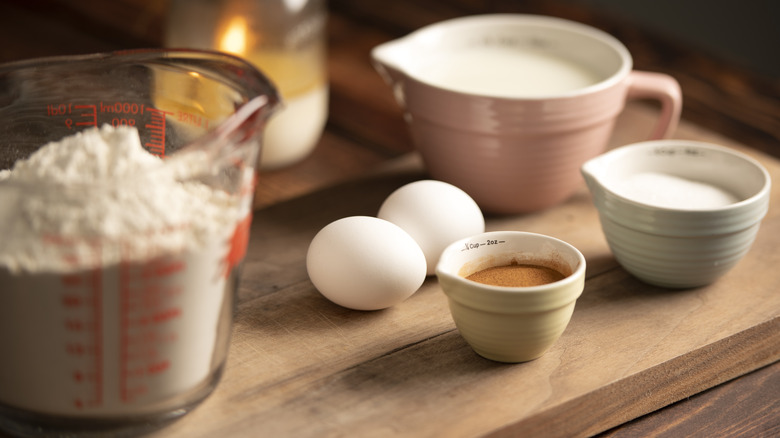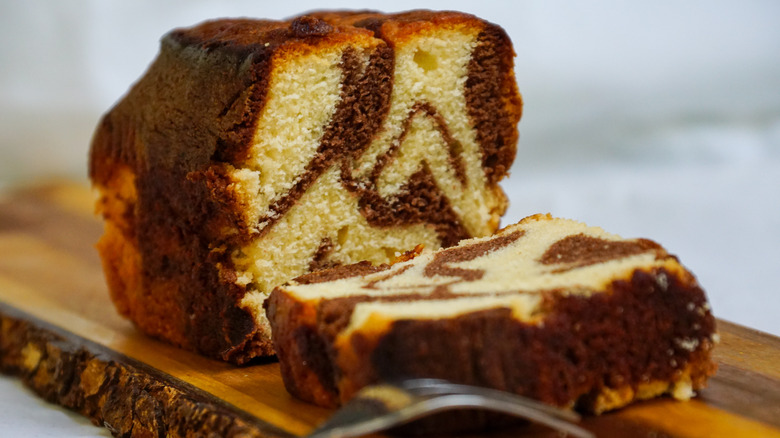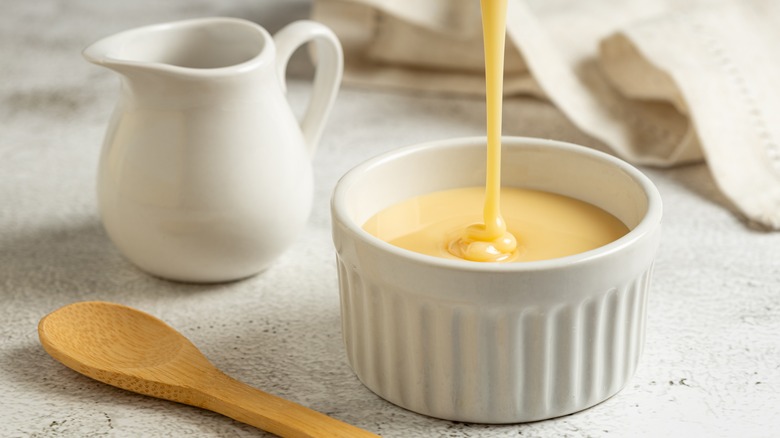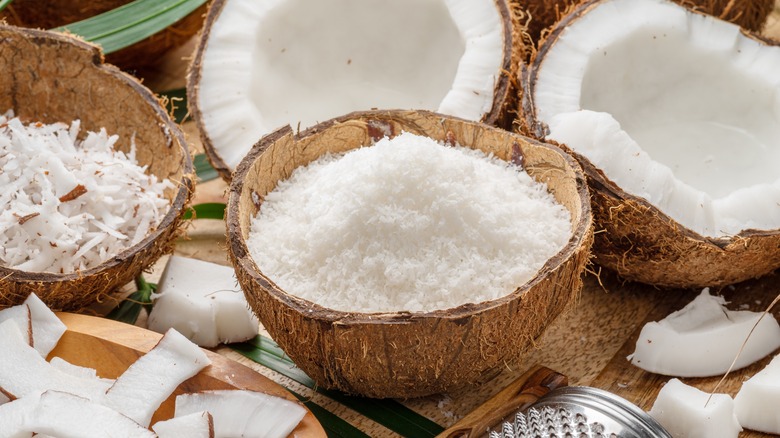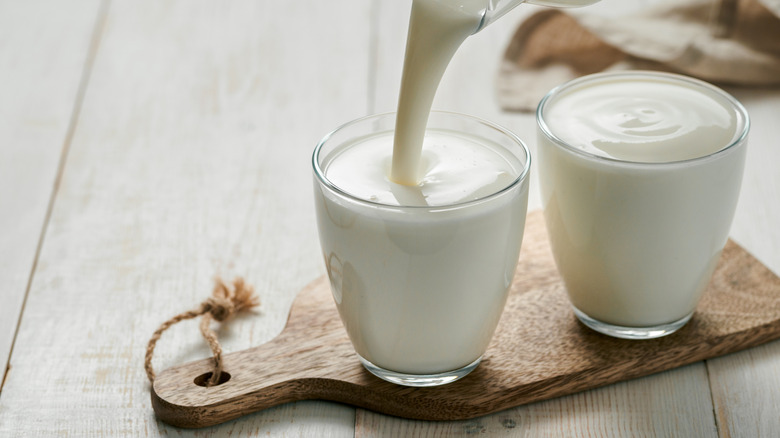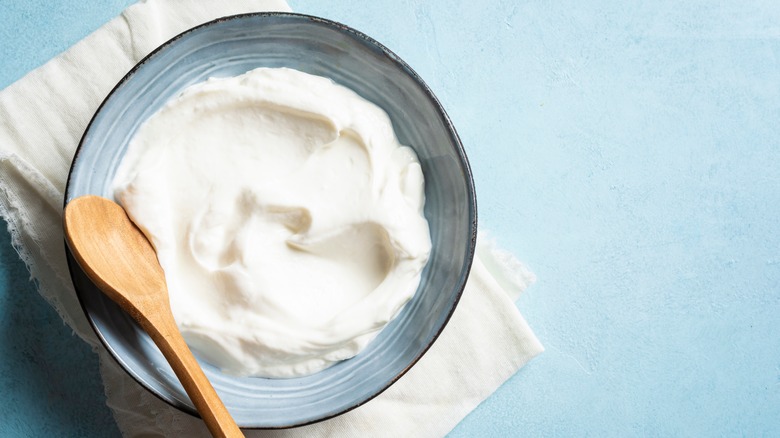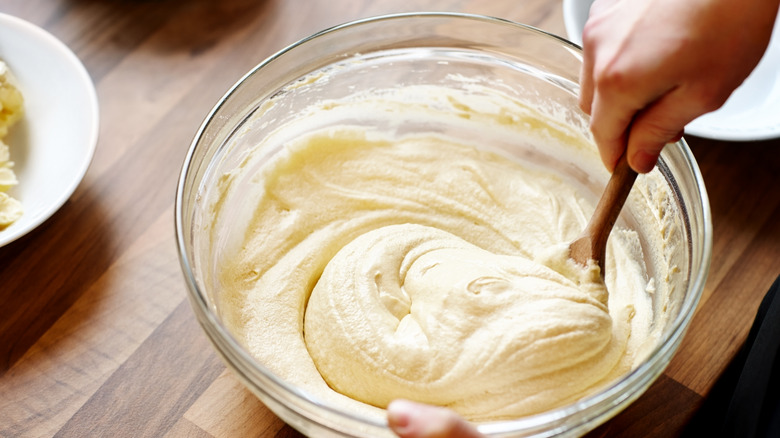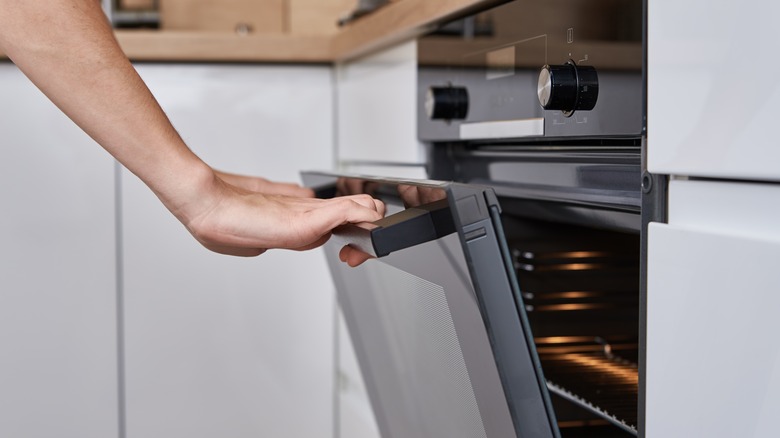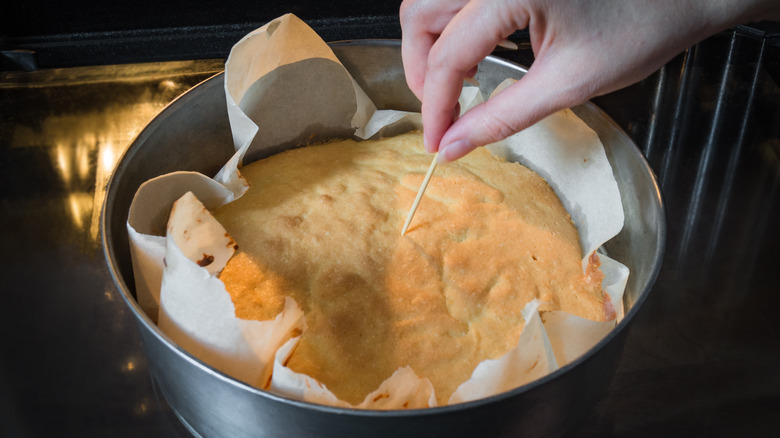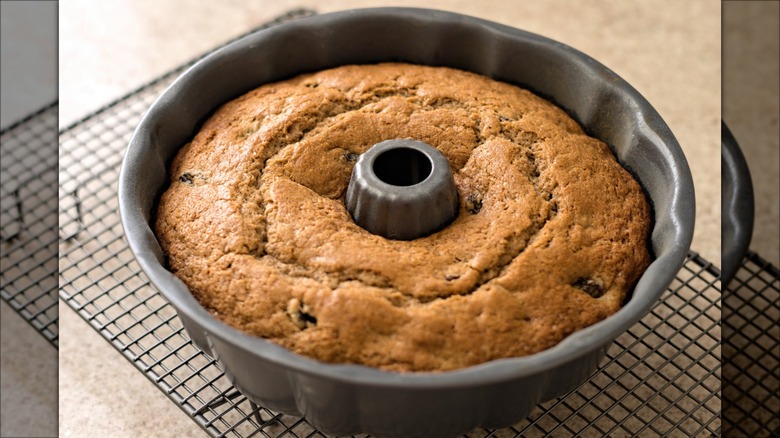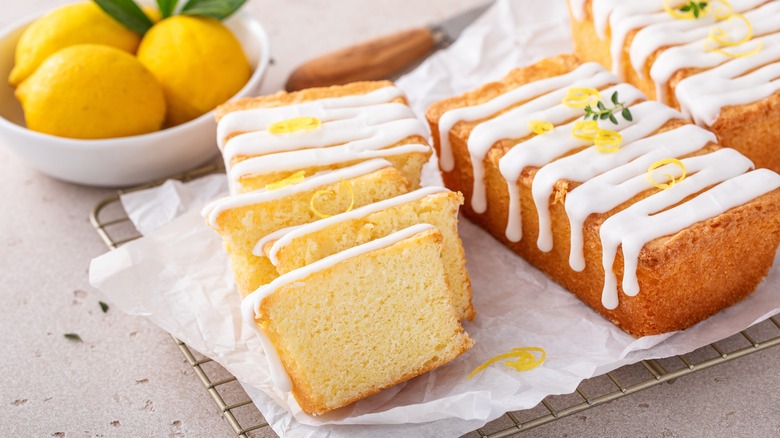Baking Expert-Approved Tips For Upgrading A Basic Pound Cake
For those who live or grew up in a Southern state, pound cake is an inescapable part of the local cuisine. Whether you're attending a church social, a county fair, or spending the weekend at your grandparents' house, this dense, tender confection is almost certain to make an appearance. Despite what you might think, pound cake is not named for its hefty weight. Instead, it's named for the traditional recipe, which called for one pound each of butter, sugar, eggs, and flour. The result is a cake so dense and moist that it feels like it weighs significantly more than the sum of its parts.
As the original four-ingredient, single measurement recipe demonstrates, pound cake is a masterclass in simplicity. You don't need to raid your cupboards or your utensil drawer to make it, and there is plenty of room to add new ingredients. Keep in mind, however, that altering a pound cake recipe isn't the same as altering other cake recipes. "Making a pound cake comes with unique challenges compared to other cakes," said Megan Weimer, the recipe developer behind the website Dollop of Dough. "One of the main difficulties is achieving the right texture. It should be dense but still moist, unlike other cakes that have a more tender, fluffy texture." We spoke with three baking experts to find out how to alter a pound cake recipe without losing its distinctive elements, and which variations they find themselves returning to again and again.
Add citrus
For a quick upgrade to pound cake, citrus is the perfect option. It cuts through the richness of the cake without altering its texture, and provides a bright zing of flavor that isn't too adventurous. Recipe developer Kristyn Merkley of Lil' Luna is fully onboard with this ingredient addition. "Our favorite flavor variation to add to a sweet and buttery pound cake is lemon," she said. "You can add this as extract or zest in the batter, or my favorite is to add a lemon glaze. It adds a lightness to the heavy, buttery cake that is to die for."
Our zesty iced lemon pound cake recipe does just that. In fact, it includes lemon in both the batter and the glaze, calling for the juice of two lemons and the zest of one. If you want to try a different citrus fruit, our pound cake with a twist provides something completely different. Instead of relying on the standard lemon or orange, it uses grapefruit and lime. Sweet, tangy, and full of the distinctive flavor of both fruits, it is a showstopping recipe that demonstrates how one or two ingredient additions can radically alter a familiar recipe.
Add pumpkin
When sweater weather rolls around and you start thinking about cozy recipes and bulky sweaters, don't just stop at pies and spiced cookies — pound cake can be the perfect autumnal baking project. For recipe developer Alyssa Rivers of The Recipe Critic, pumpkin purée is all you need. "Not only does the pumpkin help [the cake] maintain its moisture," she said, "[B]ut the spices added take it to the next level. It makes it a fun twist to the traditional sweet pound cake and adds a bit of spice and flavors of fall."
To incorporate pumpkin into pound cake, all you need is a can of pumpkin purée and pumpkin pie spices if the purée isn't already spiced. Add the pumpkin after you've creamed the butter and sugar and beaten the eggs. Add chopped pecans, a maple glaze, or a dash of confectioner's sugar and pumpkin pie spice to complete the fall theme, and get ready to enjoy this delicious autumnal cake with a cup of hot cocoa or a cozy cup of tea.
Use room temperature ingredients
Recipes often contain certain directives about how to prepare or incorporate the ingredients. For example, you might see that a recipe tells you to bring your ingredients to room temperature before using them. It's tempting to skip this sort of instruction. It can take twice as long to bring a stick of butter to room temperature as it does to make the entire recipe, but as Megan Weimer explained, like it or not — this step is non-negotiable.
"Bringing ingredients to room temperature before making a pound cake is essential for a few reasons," she said. "First, room temperature butter creams more easily with sugar, creating a smooth and airy mixture that helps give the cake its tender crumb. Cold butter won't incorporate as well ... Room temperature eggs and dairy also blend more seamlessly into the batter, ensuring that everything mixes evenly. This helps prevent curdling, where the batter might separate if cold ingredients are added to room temperature ones. All the ingredients need to be evenly mixed to achieve a uniform texture and proper rise."
These factors are all the more important with pound cake since it is already prone to being dense. You want it to rise as much as possible or it will be a rubbery brick. Bringing the ingredients to room temperature is the first step to achieving a lofty rise and a tender crumb.
Make it a marble pound cake
Marble cakes have the wow factor that pound cakes are often lacking, at least in their appearance. Instead of making a chocolate or plain vanilla cake, a marble cake allows you to do both, and have something to show for it. Cut into one of these confections and you'll see a swirl of honey brown and chocolate brown, like a slab of marble. The effect looks like it would be difficult to pull off, but it's a breeze as long as you don't overthink it.
Our moist marble pound cake recipe gives you all the details you need to make your rendition of the cake a success. You'll start by making a basic pound cake batter. Then, you'll transfer a cup of it into a separate bowl and mix it with cocoa powder and milk until it becomes a smooth, uniform, dark brown color. With the two batters, you will begin filling your prepared cake tin one tablespoon at a time, alternating between batters. Lastly, you'll take a knife or a skewer and swirl it around the batter, bringing the tip right to the surface to make sure the marbling effect is visible from the outside.
The most common mistake with marble cakes is over-swirling. If you spend too much time circulating the skewer around the tin, the batters will mix into one shade of brown and you'll lose the marble effect altogether. Remember that less is usually better, and you'll do just fine.
Add condensed milk
Another way to add marbling to a cake without creating two colors of batter is to swirl in a moist ingredient like jam or Nutella. One option that doesn't get enough attention is condensed milk. It might not sound particularly exciting, but let it simmer for a while before adding it to the batter and you'll have a dulce de leche cake that is so delicious you'll never want to make a plain pound cake again.
The easiest way to make dulce de leche at home is to put an unopened can of condensed milk into a pot of water and let it simmer for several hours. You will probably see warnings on the internet and even on the can itself that heating it unopened may make it explode, however, cooks have been simmering condensed milk without cracking the can for decades, and many would attest that it's perfectly safe. Ultimately, it's up to you, and you can easily make dulce de leche with an open can. The only downside is that it may leak into the water and leave a mess.
Once you've turned your can of condensed milk into dulce de leche, swirl it into your pound cake batter the way you would for a chocolate and vanilla marble cake and proceed with the recipe as usual. You can always use store-bought dulce de leche, but making your own allows you to choose how dark and flavorful you want it.
Add coconut
There is a limited number of ingredients that can be added to cake without altering its texture. Fruit is a delicious addition, but there is no way to add all that moisture without having to adjust the proportion of wet and dry ingredients. Even dried fruit can change the texture of a cake, especially when it all ends up in a clump at the bottom of the pan. Aside from citrus zest, cocoa powder, and spices, coconut should be a go-to. It might not be as high-profile a variation as lemon or chocolate, but for a relatively mild ingredient, it packs a lot of flavor into the mix.
There are several ways to add coconut to a pound cake. You could simply use coconut extract, but it can often taste artificial. Sprinkling desiccated coconut on top of the cake will add a hint of crunchy texture, but it won't add much to the flavor. To go all out with the tropical ingredient, add desiccated coconut to the batter, and add coconut oil or coconut milk (or both if you're really wanting that coconut flavor). Just make sure to use unrefined coconut oil. Also called virgin and pure coconut oil, unrefined coconut oil undergoes minimal processing and retains its flavor, while refined coconut oil has a neutral flavor.
Use buttermilk
If you haven't baked with buttermilk, you're in for a treat. This cultured dairy product is often substituted with yogurt or a combination of milk and lemon juice, but its particular mixture of fat and dairy is incomparable, and it's worth having some in your fridge just for baking. Unlike milk, buttermilk has a thick texture, providing body to the batter rather than runniness. If you merely swap buttermilk for milk and a type of acid, you'll end up with a watery mixture that barely rises. It also has a specific tangy flavor that even yogurt doesn't provide, while its acidity helps weaken the protein in the flour, providing a more tender texture. In other words, buttermilk provides multiple advantages in baking, and simply swapping it out with something that offers just one of these elements will yield inferior results.
To test out this heroic ingredient for yourself, try Tasting Table's zingy lemon buttermilk pound cake recipe. With the pleasing tang and tenderness from the buttermilk, it's a delicious cake that showcases what this underappreciated dairy product can do.
Add sour cream, yogurt, or cream cheese
When we asked Megan Weimer, Kristyn Merkley, and Alyssa Rivers what ingredient they swear by for enhancing a basic pound cake recipe, all three said sour cream, yogurt, cream cheese, or all three. "I love adding sour cream or plain Greek yogurt to pound cake batter," Weimer said. "The extra fat and acidity in these ingredients help retain moisture during baking and give the cake a tender, rich texture. Adding one of these ingredients makes a huge difference in keeping the cake from drying out!"
Merkley had similar advice, saying that cream cheese helps add moisture without increasing the density of the cake, while Rivers noted that sour cream adds a pleasantly tangy note that blends perfectly with the richness of the butter and vanilla.
Even though pound cake was originally a simple 1-to-1-to-1-to-1 ratio of butter, sugar, eggs, and flour, many recipes now include some form of cultured dairy, be it full-fat yogurt, buttermilk, sour cream, or cream cheese. Our recipe for moist pound cake, for example, calls for ½ a cup of sour cream. These ingredients aren't a guarantee that you'll end up with a perfectly moist, tender cake, but choosing a recipe that contains one of them will put you on the right track.
Don't over or under-mix the batter
Many recipes for quick breads and cakes stress that the wet and dry ingredients should only be mixed until combined. Since much of the rise in these baked goods is achieved by trapping air into the eggs and butter when whipping them, it's crucial that you don't knock that air out of them again when you add the heavy dry ingredients. Overmixing also over-develops the gluten in the flour, making it tough and rubbery. An overmixed cake will be flat and even denser than a standard pound cake is meant to be.
On the flip side, undermixing is also a concern. If you've ever ended up with a cake, muffin, or quick bread that has a dense, almost gummy layer at the bottom, you may have already fallen into this trap. Although overworking the gluten can lead to a tough cake, you still need a little bit of gluten formation to provide structure to the batter. Undermixing gives it a weak structure that struggles to rise, leaving you with only a partially risen cake.
To avoid overmixing, make sure all the ingredients are room temperature before starting the recipe. It takes much longer to mix cold ingredients into a smooth consistency, and you'll be forced to let the mixer run for too long. To avoid undermixing, make sure the ingredients really are fully incorporated. Wipe down the sides of the bowl with a spatula, and follow the specified timings in the recipe carefully.
Bake it at a low temperature
One of the common pitfalls that Megan Weimer warned about when making pound cake is simultaneously over and underbaking it. "[S]ince pound cakes are thicker and take longer to bake than cake layers," she said, "[I]t's easy to over bake the outside while the middle remains undercooked." Checking regularly for doneness is a good place to start, but if you want to ensure that your cake won't have a burnt outside and a raw middle, turn your oven down to a lower temperature than other cakes require. 325 degrees Fahrenheit may not be the temperature you use when baking banana bread or a Victoria sponge, but it is low enough to allow the middle of a pound cake to cook without burning the outside.
Another option is to put the cake in a cold oven and allow it to bake at the oven heats. This unconventional method is a favorite technique of pastry chefs and even Ina Garten. Instead of baking the cake from the outside in, this option ensures that the middle of the cake heats at a similar rate as the outside — at least until the oven has preheated. As a result, the middle will be done before the outside burns.
Don't worry about the toothpick being clean
Overbaking is a common pitfall when making pound cake not only because it takes the inside longer to bake than other cakes, but because many people look for the wrong signs when determining whether it's finished. As Kristyn Merkley explained, you can judge the doneness of most cakes by inserting a toothpick in the center and making sure it comes out clean. However, with a pound cake, you actually don't want the toothpick to be spotless. According to Merkley, there should be a few crumbs clinging to it. If you remove the toothpick and it's dry and crumbless, your cake is overbaked.
Megan Weimer told us that checking the cake often is one of the best ways to avoid cooking it too long. It will take longer to bake than most cakes due to its volume and density along with the low oven temperature, but checking it with a toothpick several times will ensure that you don't accidentally overbake it. Once it's overbaked, there's nothing you can do to turn back time.
Let it sit before turning it out of the tin
Once you get that cake out of the oven, it's hard not to dig right in. You at least want to taste it to make sure it's okay. Just one teeny sliver won't ruin the whole cake, right? Well, not exactly, but letting it sit for 10 minutes before removing it from the pan will actually make a significant difference. If you dump your cake out of the pan immediately, it may get stuck and end up half in, half out. The best-case scenario is that it comes out in one piece but has a tough, cardboardy crust. Letting your cake sit in the tin allows it to steam slightly, keeping the edges moist and springy. Taking it out too soon allows all that hot, moist air to escape rather than be trapped in the pan and directed back into the cake.
All the cake needs is 10 to 15 minutes. If you leave it in the pan much longer than that, it may settle into the bottom, become soggy, and be impossible to remove.
Give it a topping
Adding a topping is the safest way to upgrade pound cake because you don't have to worry about what the extra ingredients will do to the texture or the rise. It also gives you plenty of options to choose from. Kristyn Merkley provided some guidance about where to start. "The important thing when choosing a topping or glaze is to think light and fresh," she said. "This offsets the dense, buttery cake well. We love a lemon glaze as mentioned before, but another great variation is a mascarpone or cream cheese-based whipped topping with some fresh, lightly sweetened strawberries or blackberries. If you want a really delicious pound cake variation, you can even make French toast with it and some heavenly buttermilk syrup."
Alyssa Rivers had similar ideas. "Most of the time I like to add fresh berries, whipped cream or a sprinkle of powdered sugar," she said. "But I am not about to turn down a delicious brown butter glaze on top of a pound cake, either! Citrus glazes, nuts and jams all make for great toppings, too."
